Stories
Mary Garden
1893-1962
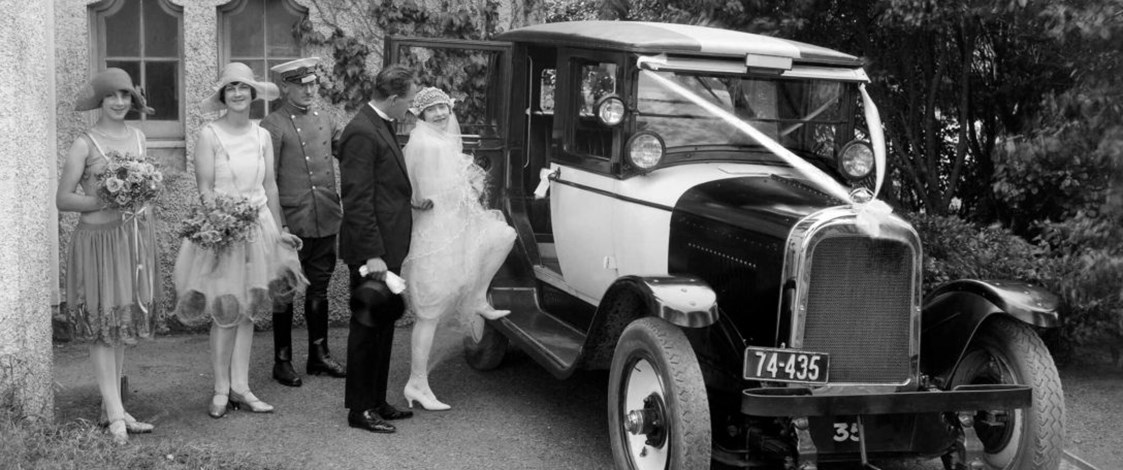
In the 1920s the societal norms shattered in the First World War, combined with a booming economy, led to the emergence of a new generation of emancipated young women – the 'flappers'.
They wore hemlines above the ankle, cut and bobbed their hair, listened to jazz and generally rebelled against the path that society expected young women to follow. They smoked cigarettes (gaspers), drank alcohol, took lovers rather than husbands, sought employment and flaunted their disdain for what was then considered acceptable behaviour. For more than a decade, one woman was looked up to by this new generation in Wellington, someone who 'had it all'; a fashion designer, businesswoman and property developer who lived and worked under the pseudonym Mary Garden.
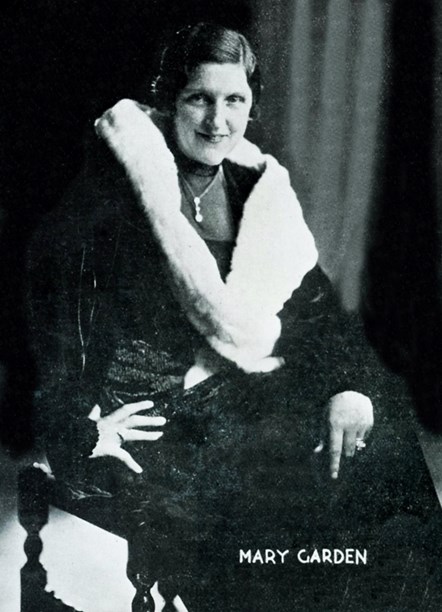
Ruby Wilson as Mary Garden. Image from ‘The Social Review’, January 1934.
She was born in Hobart in Tasmania in January 1893 as Ruby Russell and likely grew up on a farm not far from that city. However, Ruby had bigger ambitions; training as a dressmaker, she went on to develop her craft at the luxurious Farmers & Co department store in central Sydney (unconnected to the New Zealand retail chain of the same name).
In 1924 she moved to Wellington and established her own dress-making business upstairs at 100 Manners Street. Shortly after arriving in New Zealand she reinvented herself and took on her pseudonym having lifted the name from the 'real' Mary Garden, a legendary Scottish-born opera singer and silent movie star, famous for her beauty, talent and wealth.
'Mary Garden Creations' soon became one of Wellington’s best-known local fashion labels producing "exclusive but inexpensive" clothes for New Zealand women and within a year over 40 staff were employed to turn Ruby’s designs into reality.
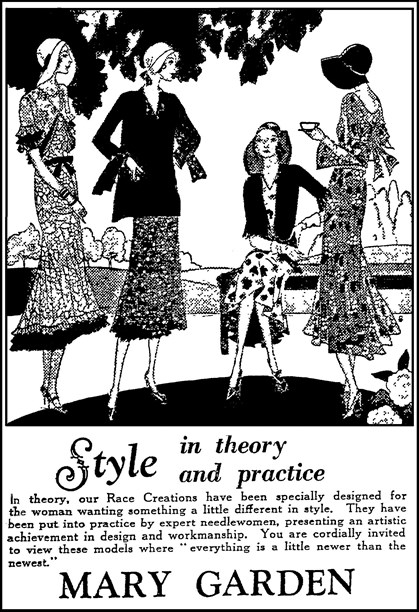
Ad for Mary Garden's 'race creations', Auckland Star, 30 September 1930.
Around the time her business was established she met Maurice Wilson, a dashing veteran of the First World War who had recently migrated to New Zealand from England and they soon fell in love. Though he was working for the Avery Scales Company as a travelling salesman, he was very familiar with the textile trade having grown up in Bradford in Yorkshire where his father owned a factory producing woollen yarn and his knowledge and contacts in the UK would have been very useful to Ruby’s business.
In February 1926 Ruby and Maurice were married at the Presbyterian church which was once on the corner of Kent Terrace and Pirie Street, the bride wearing a fabulous dress and hat very likely of her own creation while her husband stuck to a traditional dark suit and top hat.
The couple moved into a flat on fashionable Oriental Parade and for the next four years Maurice worked in his wife’s business. Together they attended parties, the races and social gatherings befitting of their status. However, it was her name above the door and to some extent Maurice was a kept man with Ruby keeping her business at arm’s length from her husband. Though officially now Ruby Wilson, for the purposes of her business and the society-party circuit, she remained known to everyone as Mary Garden. Branches of Mary Garden Creations soon opened in Palmerston North and Hastings and the money poured in.

Label from a Mary Garden Jacket. Image courtesy of Te Papa, PC003384.
Despite the 1929 Wall Street Crash and the onset of the Great Depression, Mary Garden Creations remained profitable and advertising for the firm around this time often pointed out the number of 'girls' employed (over 100 by the early 1930s), something to be proud of when so many businesses were closing their doors and unemployment was reaching record levels.
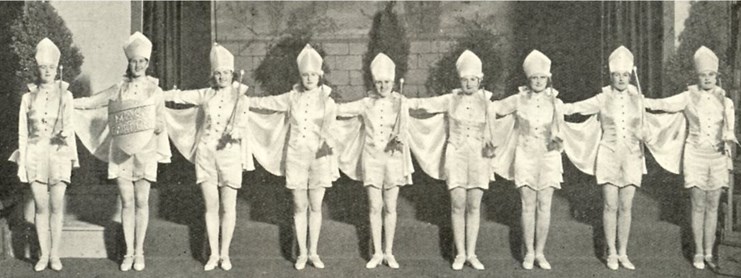
The ‘Garden Girls’ competition marching team selected from the staff of Mary Garden with uniforms designed and made in-house. The Social Review, May 1934.
In August 1930, Ruby announced to the press that she was embarking on a combined business and pleasure trip to "the most important fashion centres of the world" including New York, London, Berlin and Paris. She travelled to Auckland and set off on the S.S. Aorangi on the first leg of her tour.
Ruby returned to New Zealand full of new and creative ideas of how her business could continue to grow despite the severe economic downturn of the Great Depression.
Mary Garden evening dresses, 1934.
In 1931 she sold a substantial share in her company (keeping a majority for herself), possibly to raise capital to inject into the new branch of Mary Garden which had opened at 140 Queen Street in Auckland and she was soon regularly travelling between the two cities.

Ad for Mary Garden's Queen Street, Auckland salon. NZ Herald, 31 March 1931.
Around this time Mary Garden Creations left their Manners Street premises and she opened a new boutique showroom and workshop at 260a Lambton Quay. Within a couple of years the retail outlet moved across the road to the much more fashionable 'Harcourt Chambers' which were once located on the corner of Lambton Quay and Panama Street.
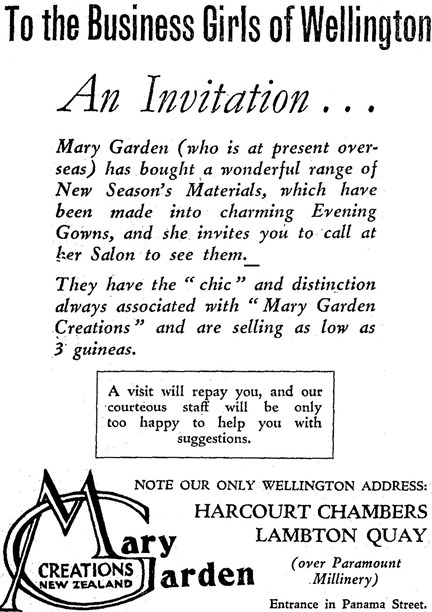
Ad for Mary Garden Creations at Harcourt Chambers on Lambton Quay. Evening Post, 3 April 1937.
By the late 1930s, Ruby had had enough of being a businesswoman. She had considerable assets and had worked hard for many years; it was time to take things a little easier. It’s also possible that she may have struggled to adapt to the new fashion trends and she began to wind up her firm. When her lease in the Harcourt Chambers came to an end, she sold off her equipment and remaining stock and in late June 1938 Mary Garden Creations was removed from the Companies Register. Her staff were 'let go' but many went into business as dressmakers themselves, proudly stating how they had formerly been an employee of Mary Garden, such was her reputation. She then took a senior position within the dress department of The DIC department store on Lambton Quay just across the road from where her business had been located.
Twice-widowed, Ruby moved to Auckland where she lived on the North Shore for a brief period in the mid-late 1940s, before leaving New Zealand in 1952 to travel to the UK before returning to Australia. She purchased a unit in the famous Glenhurst Gardens modernist apartment complex at Darling Point in Sydney around the time the building was being constructed and was still living there when she died in May 1962, aged 69.
Text by Gábor Tóth, an edited version of his blog 'The Enigma of Mary Garden' for Wellington City Libraries. Banner image of the wedding of Ruby Russell (Mary Garden) and Maurice Wilson. Photo by Crown Studios, courtesy of the Alexander Turnbull Library, /1-038629-F.
Published March 2021.